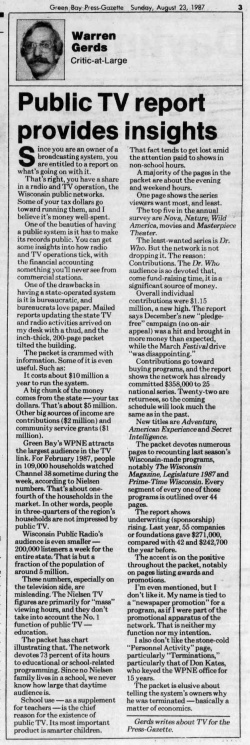Public TV report provides insights
- Publication: Green Bay Press-Gazette
- Date: 1987-08-23
- Author: Warren Gerds
- Page: 3
- Language: English
Since you are an owner of a broadcasting system, you are entitled to a report on what's going on with it.
That's right, you have a share in a radio and TV operation, the Wisconsin public networks. Some of your tax dollars go toward running them, and I believe it's money well-spent. One of the beauties of having a public system is it has to make its records public. You can get some insights into how radio and TV operations tick, with the financial accounting something you'll never see from commercial stations.
One of the drawbacks in having a state-operated system is it is bureaucratic, and bureaucrats love paper. Mailed reports updating the state TV and radio activities arrived on my desk with a thud, and the inch-thick, 200-page packet tilted the building.
The packet is crammed with information. Some of it is even useful. Such as:
It costs about $10 million a year to run the system.
A big chunk of the money comes from the state —your tax dollars. That's about $5 million. Other big sources of income are contributions ($2 million) and community service grants ($1 million).
Green Bay's WPNE attracts the largest audience in the TV link. For February 1987, people in 109,000 households watched Channel 38 sometime during the week, according to Nielsen numbers. That's about one-fourth of the households in the market. In other words, people in three-quarters of the region's households are not impressed by public TV.
Wisconsin Public Radio's audience is even smaller —200,000 listeners a week for the entire state. That is but a fraction of the population of around 5 million.
These numbers, especially on the television side, are misleading. The Nielsen TV figures are primarily for "mass" viewing hours, and they don't take into account the No. 1 function of public TV —education.
The packet has chart illustrating that. The network devotes 73 percent of its hours to educational or school-related programming. Since no Nielsen family lives in a school, we never know how large that daytime audience is.
School use —as a supplement for teachers —is the chief reason for the existence of public TV. Its most important product is smarter children.
That fact tends to get lost amid the attention paid to shows in non-school hours.
A majority of the pages in the packet are about the evening and weekend hours.
One page shows the series viewers want most, and least.
The top five in the annual survey are Nova, Nature, Wild America, movies and Masterpiece Theater.
The least-wanted series is Dr. Who. But the network is not dropping it. The reason: Contributions. The Dr. Who audience is so devoted that, come fund-raising time, it is a significant source of money.
Overall individual contributions were $1.15 million, a new high. The report says December's new "pledge-free" campaign (no on-air appeal) was a hit and brought in more money than expected, while the March Festival drive "was disappointing."
Contributions go toward buying programs, and the report shows the network has already committed $358,000 to 25 national series. Twenty-two are returnees, so the coming schedule will look much the same as in the past.
New titles are Adventure, American Experience and Secret Intelligence.
The packet devotes numerous pages to recounting last season's Wisconsin-made programs, notably The Wisconsin
Magazine, Legislature 1987 and Prime-Time Wisconsin. Every segment of every one of those programs is outlined over 44 pages.
The report shows underwriting (sponsorship) rising. Last year, 55 companies or foundations gave $271,000, compared with 42 and $242,700 the year before.
The accent is on the positive throughout the packet, notably on pages listing awards and promotions.
I'm even mentioned, but I don't like it. My name is tied to a "newspaper promotion" for a program, as if I were part of the promotional apparatus of the network. That is neither my function nor my intention.
I also don't like the stone-cold "Personnel Activity" page, particularly "Terminations," particularly that of Don Kates, who keyed the WPNE office for 15 years.
The packet is elusive about telling the system's owners why he was terminated — basically a matter of economics.
Disclaimer: These citations are created on-the-fly using primitive parsing techniques. You should double-check all citations. Send feedback to whovian@cuttingsarchive.org
- APA 6th ed.: Gerds, Warren (1987-08-23). Public TV report provides insights. Green Bay Press-Gazette p. 3.
- MLA 7th ed.: Gerds, Warren. "Public TV report provides insights." Green Bay Press-Gazette [add city] 1987-08-23, 3. Print.
- Chicago 15th ed.: Gerds, Warren. "Public TV report provides insights." Green Bay Press-Gazette, edition, sec., 1987-08-23
- Turabian: Gerds, Warren. "Public TV report provides insights." Green Bay Press-Gazette, 1987-08-23, section, 3 edition.
- Wikipedia (this article): <ref>{{cite news| title=Public TV report provides insights | url=http://cuttingsarchive.org/index.php/Public_TV_report_provides_insights | work=Green Bay Press-Gazette | pages=3 | date=1987-08-23 | via=Doctor Who Cuttings Archive | accessdate=21 December 2025 }}</ref>
- Wikipedia (this page): <ref>{{cite web | title=Public TV report provides insights | url=http://cuttingsarchive.org/index.php/Public_TV_report_provides_insights | work=Doctor Who Cuttings Archive | accessdate=21 December 2025}}</ref>
